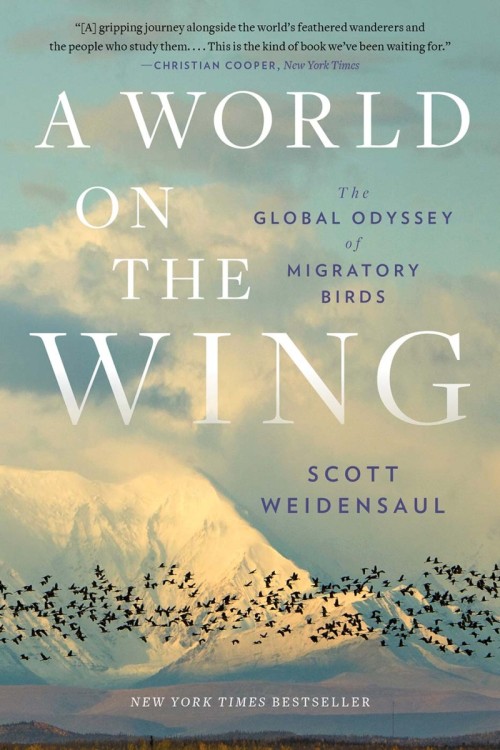by Scott Weidensaul
W.W. Norton 2021
Several years ago, on a wet March morning, more than a hundred robins appeared in my upper pasture, everywhere and hungry. They dashed about the sorry-looking grass, stooping, pecking, swallowing worms, and then left, abruptly . . . a small part of the feathered world in flux. This past winter, small bands of robins roamed east-central Vermont, dooryard-to-dooryard, storefront-to-storefront, gorging on withered crabapples and highbush cranberries. But, in the 1960s (and later), robins were the harbinger of spring, one of the first birds to migrate back to New England, sometime in late March or early April. Back then, wintering robins were so unusual in northern New England that their appearance was noted on rare bird hotlines, the forerunner of the birding listserv.
Climate change has rewritten, and continues to rewrite, the timing of bird migration. “It is tearing up the calendar,” writes Scott Weidensaul in A World on the Wing, his most recent contribution to the natural history of our planet. As globetrotting as his subjects, Weidensaul takes his reader from China’s Yellow Sea to northern Michigan, from a neighborhood in Pennsylvania to Cyprus, and from central Alaska to Argentina.
Along the way, we are introduced to a migratory bird’s breathtaking navigational and physiological accomplishments and to the recent revolution in geolocators. These miniaturized tracking devices enable someone to follow the transcontinental flight of a blackburnian warbler or to pinpoint wintering territories and staging grounds of widely disjunct Hudsonian godwit populations on their laptop. We’re introduced to leading field biologists and community scientists whose lives revolve around understanding the mysteries of bird migration, while anticipating an uncertain climate future.
Weidensaul notes that the effects of our ever-twisting calendar vary by species. Arctic breeding waterfowl and shorebirds are among the species groups that lose out. As the tundra defrosts earlier, a hatching bonanza of midge and mosquito larvae – stimulated by the rising temperatures – become less available to chicks, whose parents arrive on the tundra according to species-specific photoperiods. There is a “galloping seasonal change and a parallel but lagging response from birds,” the so-called phenological mismatch, which jeopardizes long-distant migrants far more than short-distant migrants like my dooryard robins.
Mismatches in phenology are less of a concern for black-throated blue warblers and American redstarts. In the Northeast, the abundance and diversity of insects in a northern hardwood forest buffer the effects of climate change. We have no summer insect peak, thus our local migrants have an “ever-changing buffet” of soft-bodied insects to feed their chicks, a menu that includes hundreds of species of protein-rich caterpillars.
Birds are stunning navigators (a fact long known). But did you know they might be able to visualize Earth’s magnetic field (not sense it … visualize it)? Birds are also stunning athletes; before migration they build muscle mass without exercising, biochemically bulking up (no gym membership for them). The result: a fist-sized sandpiper flies nonstop from northern Canada to Venezuela – the equivalent of running 126 consecutive marathons – without food, drink, or rest. Migrating birds don’t suffer sleep deprivation either.
You may already know that some ruby-throated hummingbirds fly nonstop 600 miles across the Gulf of Mexico. But did you know some sooty shearwaters fly 46,000 miles a year, some Arctic terns 57,000? Both species circumnavigate the oceans of the world. “It’s a helluva road trip,” Weidensaul notes.
While visualizing on Google Earth the day-to-day flight of a gray-cheeked thrush he had banded five years earlier in Denali National Park, an epic 6,500-mile jaunt south down the crooked face of the Western Hemisphere, Weidensaul unleashes awe. “Reverence for a creature that, despite every obstacle we… have placed in its path, continues to hold faith with the wind and the far horizon… Reverence for an endurance and tenacity I cannot… fully comprehend, [leaving] me breathless… [knitting] up the scattered and beleaguered wild places of the world into a seamless whole through the simple act of flight.”
May the robins always pause in my pasture before heading north into uncertain skies.


